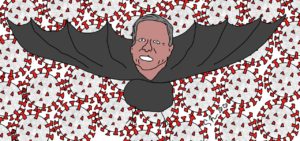by Jonathan Moreno, Ph.D. and Arthur Caplan, Ph.D.
For a moment, let’s suppose that the novel coronavirus was produced by a lab in Wuhan as a biological weapon, as some in the Trump Administration have alleged. In that fictional scenario, we have nothing to fear from utterly inept Chinese military planners: They’d have developed a malign microbe that strikes mainly at old and sick people, not the healthy, young people who fight wars and power economies.
Smart medical warriors all know that there are already bugs in nature that don’t require any engineering that target the strong and youthful. And nature provides plenty of bioweapons on its own. Napoleon’s army was decimated not only by the Russian winter, but by a typhus epidemic. His six hundred thousand-man Grande Armee returned to France with ten thousand survivors. Typhoid did the same to the mighty Wehrmacht in World War II. Now those are serious biological weapons, no assembly required.
There are other reasons nation-states have abandoned bioweapons and even entered into an international agreement to police their use. One is that microbes are notoriously bad at distinguishing between friend and foe. Chemical weapons can literally blow back in the aggressor’s face. Biological weapons are still more insidious as they can lodge in your own ecosystem indefinitely. A Chinese viral bioweapon would be just as dangerous to the Chinese as it would any perceived enemy.

Although strategically useless on a large scale, biology and chemistry can and have of course been exploited by terrorist groups. That’s why the U.S. and other countries maintain laboratories to track and defend against such threats. The experts in those labs are part of a crucial international network of scientists who track emerging infectious diseases and prepare preventive, defensive measures, including the lab in Wuhan which has hosted expert American visitors.
Suppose a “natural” nasty coronavirus “escaped” from the Wuhan lab by accident. That’s what Secretary of State Mike Pompeo now theorizes, contrary to the views of intelligence agencies and actual scientists. Such accidents do happen, and this theory at least removes the excuse for a military response. But this idea implies that the scientists there had either designed it, which again would have been a remarkably stupid concept for a weapon, or that they somehow discovered it in nature.
Dozens of dangerous microbes are already on a select agent list. Singling out yet another a virus for a bioweapon out of the far more than 100 million viruses in nature far outstrips the metaphor of hunting for a needle-in-a-haystack. It means Chinese scientists looking for a needle in a vast farmland of haystacks. And to what purpose?
Yet if the Chinese had stumbled upon this virus against these crazy odds, that would have given the world more time to prepare for the pandemic since China supplied the world with the virus’s genome on January 11. Now the Trump Administration claims the Wuhan outbreak was covered up for weeks. For a moment, let’s suppose there was a coverup. Sadly, given the utter incompetence of the Trump administration, those extra weeks would have made little difference. The White House admits it was warned about the threat posed by the virus at least as early as January 23. No action was taken until February 2 and that was only a travel ban of Chinese citizens to the U.S. Many months of preparation for tests, contact tracing and protective equipment were lost.
So where did this virus likely come from? Bats are a good possibility. Many scientists, including Peter Daszak, an expert in emerging diseases believes that it’s much more likely that bats transmitted the disease to people. Based on previous research, Daszak thinks that 1- to 7-million people in Southeast Asia a year are exposed to bat viruses. Which leaves one to wonder why, obsessed with conspiracy theories, the administration cut the budget for an NIH project studying how coronaviruses spread from bats to people.
That’s what all this finger pointing about China is really about, shifting the blame to yet another convenient target for the administration’s utter negligence in responding to the COVID-19 plague. Pandemics don’t only bring disease, they also breed disorientation and suspicion. We are reluctant to accept the random and sometimes treacherous nature of nature: A world turned upside down must be somebody’s fault. Pick a nation or an ethnic group or a gender or even the World Health Organization to be the scapegoat. Then give it a name that sticks (e.g. “Chinese virus” or “failed WHO”. Then just get out of the way and let anger and fear point fingers in other directions, while you duck any responsibility for the mess we are in.
Our national leadership seems to want to design a political weapon. And that kind is even more dangerous than COVID-19.